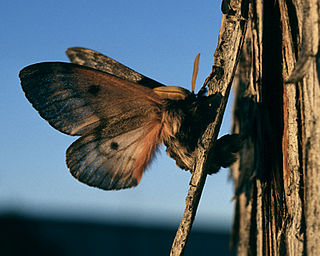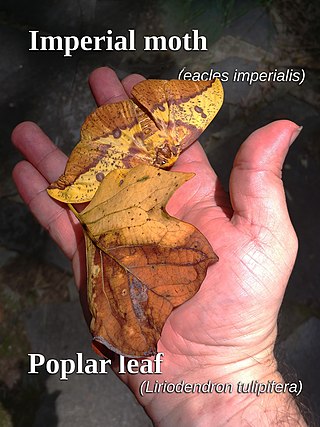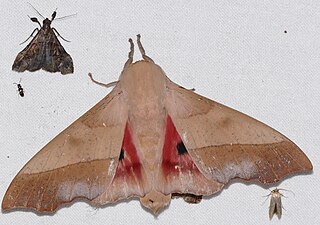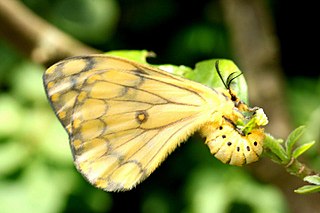Related Research Articles

Saturniidae, members of which are commonly named the saturniids, is a family of Lepidoptera with an estimated 2,300 described species. The family contains some of the largest species of moths in the world. Notable members include the emperor moths, royal moths, and giant silk moths.

Bombycoidea is a superfamily of moths, including the silk moths, giant silk moths, sphinx moths, saturniids, and relatives. The superfamily Lasiocampoidea is a close relative and was historically sometimes merged in this group. After many years of debate and shifting taxonomies, the most recent classifications treat the superfamily as containing 10 constituent families.

Coloradia is a genus of moths of the family Saturniidae. There are nine described species found in Mexico and eastern North America. The genus was first described by C. A. Blake in 1863.

Eacles is a genus of moths in the family Saturniidae. They are native to the Americas. The genus was erected by Jacob Hübner in 1819.

The dryandra moth is a species of moth that is considered to be the sole member of the family Carthaeidae. Its closest relatives are the Saturniidae and it bears a resemblance to many species of that family, bearing prominent eyespots on all wings. The common name is derived from the Dryandra shrubs of the genus Banksia, on which the larva of this species feed, and is hence restricted to the south-west of Western Australia where these shrubs grow. Other Grevillea shrubs may also be used as host plants.

Caligula is a genus of moths of the family Saturniidae. It is primarily an Oriental genus, found in India, China and Southeast Asia. The genus is often treated as a synonym of Rinaca. It is named after Roman emperor Caligula.

The Saturniinae or saturniines are a subfamily of the family Saturniidae, also known as giant silkmoths. They are commonly known as emperor moths or wild silk moths. They are easily spotted by the eyespots on the upper surface of their wings. Some exhibit realistic eye-like markings, whilst others have adapted the eyespots to form crescent moon or angular shapes or have lost their wing scales to create transparent windows. They are medium to very large moths, with adult wingspans ranging from 7.5 to 15 cm, in some cases even more. They consist of some of the largest sized Lepidoptera, such as the luna moth, atlas moth, and many more. The Saturniinae is an important source of wild silk and human food in many different cultures.

Bradina is a genus of moths of the family Crambidae.
Pseudonoorda is a genus of moths of the family Crambidae.

Gastropacha is a genus of moths in the family Lasiocampidae. It was first described by Ochsenheimer in 1810.

Automeris is a genus of moths in the family Saturniidae and the subfamily Hemileucinae. As of 1996 there were 124 species, and more have since been described. These moths are generally characterized by the eyelike patches on the hindwings and the leaflike pattern on the forewings, an example of crypsis. The genus was first described by Jacob Hübner in 1819 and it is distributed in the Neotropical realm.

Syssphinx is a genus of moths of the family Saturniidae. The genus was erected by Jacob Hübner in 1819.

Aglia is a genus of moths in the family Saturniidae first described by Ochsenheimer in 1810. It is the only genus in the subfamily Agliinae.

Hyalophora is a genus of moths in the family Saturniidae. The genus was erected by James Duncan and John O. Westwood in 1841.

Samia is a genus of moths in the family Saturniidae. The genus was erected by Jacob Hübner in 1819.
Neodiphthera is a genus of moths in the family Saturniidae. It was described by David Stephen Fletcher in 1982.

Syntherata is a genus of moths in the family Saturniidae first described by Peter Maassen in 1873.

Pseudaphelia is a genus of moths in the family Saturniidae first described by William Forsell Kirby in 1892.
Microcetus is a genus of extinct odontocete from the late Oligocene (Chattian) of Nordrhein-Westfalen, Germany.
Antistathmoptera daltonae is a moth in the family Saturniidae described by Willie Horace Thomas Tams in 1935. It is found in Tanzania, Malawi, Mozambique, South Africa, Zimbabwe and Zambia.
References
- ↑ Rougerie, R. & Collective of iBOL Saturniidae expert taxonomists (2009). "Online list of valid and available names of the Saturniidae of the World". Lepidoptera Barcode of Life.